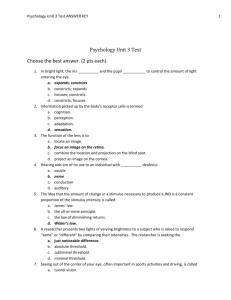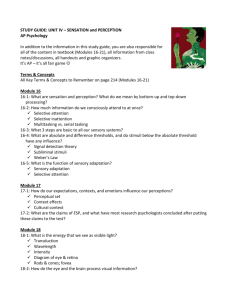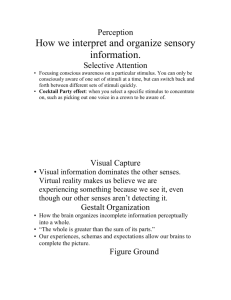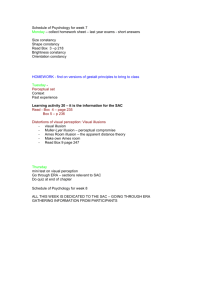Unit 3 Test.
advertisement
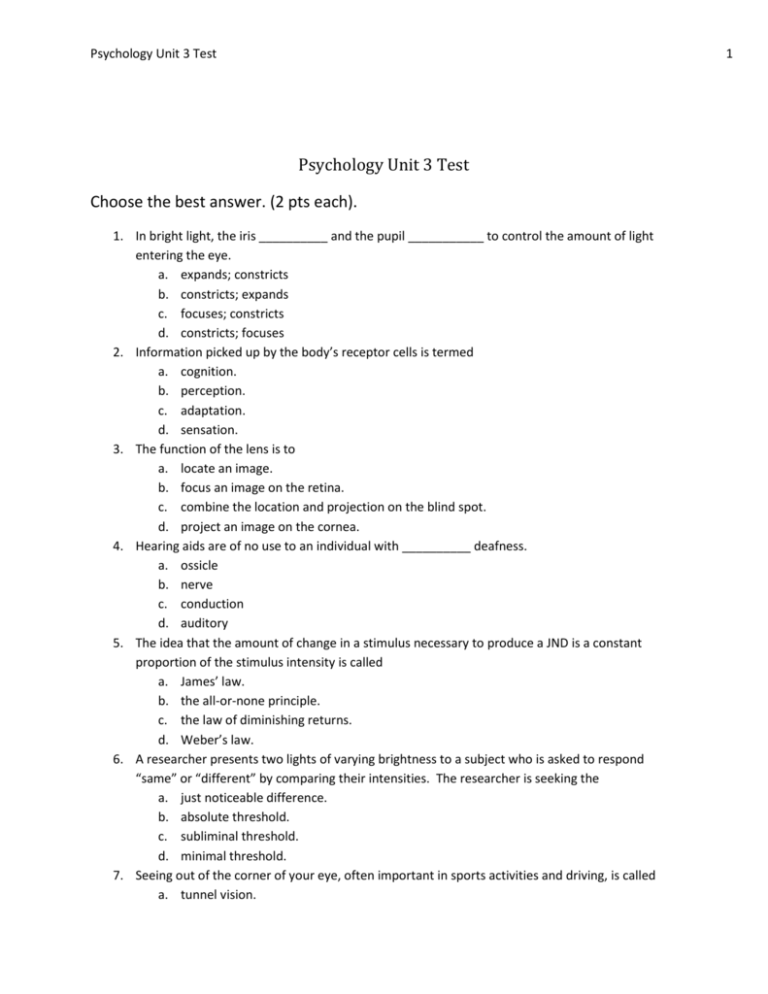
Psychology Unit 3 Test 1 Psychology Unit 3 Test Choose the best answer. (2 pts each). 1. In bright light, the iris __________ and the pupil ___________ to control the amount of light entering the eye. a. expands; constricts b. constricts; expands c. focuses; constricts d. constricts; focuses 2. Information picked up by the body’s receptor cells is termed a. cognition. b. perception. c. adaptation. d. sensation. 3. The function of the lens is to a. locate an image. b. focus an image on the retina. c. combine the location and projection on the blind spot. d. project an image on the cornea. 4. Hearing aids are of no use to an individual with __________ deafness. a. ossicle b. nerve c. conduction d. auditory 5. The idea that the amount of change in a stimulus necessary to produce a JND is a constant proportion of the stimulus intensity is called a. James’ law. b. the all-or-none principle. c. the law of diminishing returns. d. Weber’s law. 6. A researcher presents two lights of varying brightness to a subject who is asked to respond “same” or “different” by comparing their intensities. The researcher is seeking the a. just noticeable difference. b. absolute threshold. c. subliminal threshold. d. minimal threshold. 7. Seeing out of the corner of your eye, often important in sports activities and driving, is called a. tunnel vision. Psychology Unit 3 Test 8. 9. 10. 11. 12. 13. 14. 15. b. peripheral vision. c. astigmatism. d. feature detection. Difference thresholds a. occur when we can first detect some stimulus. b. occur when we can detect the change in the intensity of a stimulus. c. depend on the energy necessary to stimulate a sensory receptor. d. are measured in Judgmental Normal Differences. The incoming flow of information from our sensory system is referred to as a. sensation b. perception c. adaptation. d. cognition. The iris controls the a. thickness of the lens. b. size of the pupil. c. flexibility of the cornea. d. distance between the lens and retina. The part of the eye where the optic nerve leaves the eye is called the a. lens. b. retina. c. blind spot. d. pupil. The point at which a change in sensory stimulation is detected is called the a. absolute threshold. b. psychophysical equation. c. just noticeable difference. d. Weber Effect. Which of the following is a skin sensation? a. oomami b. olfaction c. pain d. gravity Humans respond to different wavelengths of light by experiencing differing a. colors. b. levels of brightness. c. amounts of saturation. d. amplitudes. The part of the eye that focuses the image is called the a. lens. b. retina. c. iris. 2 Psychology Unit 3 Test 16. 17. 18. 19. 20. 21. 22. d. pupil. According to Weber’s Law, if two light bulbs must go out in a room in which twenty are burning to make the room noticeably dimmer, then a room in which forty are burning will become noticeably dimmer when ___________ bulbs go out. a. two b. four c. six d. eight Sensory adaptation refers to a decrease in sensory response that accompanies a. perceptual defense. b. threshold shifts. c. an unchanging stimulus. d. selective attention. In the auditory system, the first anatomical structure to respond to the sound wave is/are the a. auditory ossicles. b. cochlea. c. eardrum. d. round window. That you do not hear the traffic outside your psychology class because you are engrossed in the lecture is a good example of a. sensory gating. b. sensory adaptation. c. selective attention. d. selective detention. When you were in seventh grade, you had to get glasses because you could not see the board at school. Your vision problem is called a. farsightedness. b. astigmatism. c. presbyopia. d. nearsightedness. Black and white vision with greatest sensitivity under low levels of illumination describes the function of a. the cones. b. the visual pigments. c. the rods. d. the phosphenes. Color vision is provided by a. the cones. b. the visual pigments. c. the rods. d. the phosphenes. 3 Psychology Unit 3 Test 23. After a musical concert that you enjoyed without distraction, a companion complains that she heard little of the music due to frequent shuffling and throat-clearing in the audience. The difference in your experience and hers is related to a. just noticeable differences. b. subliminal thresholds. c. sensory adaptation. d. selective attention. 24. The cones of the retina a. are densely packed in the periphery of the retina. b. are specialized for black, white, and gray sensations. c. function best in bright light. d. are responsible for night vision. 25. The frequency of a sound determines its a. hue. b. intensity. c. amplitude. d. pitch. 26. Experiments involving infants’ perception of 3-D figures, when combined with visual cliff data, suggest that a. at least some level of depth perception is innate. b. depth perception is heavily dependent on skillful motor coordination. c. depth perception is almost entirely learned. d. neither innate mechanisms nor learning have much effect on depth perception. 27. If you stand in the middle of a cobblestone street, the street will look course near your feet and finer if you look into the distance. This is called a. texture gradient. b. linear perspective. c. relative size. d. relative motion. 28. When traveling in a car, near objects seem to move past you faster than distant objects. This is called a. aerial perspective. b. linear perspective. c. relative size. d. relative motion. 29. You are sitting in the pit area at the Indianapolis 500. You closely watch one of the cars whiz around on the track in front of the seething mass of humanity crammed into the stands. You have organized this visual scene such that the race car is _______________ and the people and the stands are _____________________. a. figure; ground b. ground; figure c. figure; common region 4 Psychology Unit 3 Test 30. 31. 32. 33. 34. 35. 36. 37. d. common region; camouflage The fact that objects that are near each other tend to be grouped together is known as a. closure. b. continuation. c. similarity. d. proximity. The tendency to group together objects that are the same size, shape, color, or form is known as a. closure. b. continuation. c. similarity. d. nearness. As a door opens toward you, you perceive it as a rectangular door rather than going through actual image changes on the retina (from rectangular to trapezoid). This is an example of a. perceptual closure. b. shape constancy. c. ambiguous stimuli. d. retinal disparity. Closure, nearness, similarity, and continuation are categories of a. perceptual (Gestalt) organization. b. cognitive style. c. cognitive organization. d. perceptual integration. The tendency to fill in gaps in the perception of a figure is called a. sensory completion. b. closure. c. figure-ground. d. continuation. Twenty extremely accurate clocks are locked in two bank vaults (ten in each). A subject who claims to have paranormal powers concentrates on the clocks in one of the vaults, attempting to make them run faster. If she succeeds, she will have demonstrated a. clairvoyance. b. telepathy. c. mesmerism. d. psychokinesis. Attention is aroused by a. subtle differences in stimuli. b. bright stimuli. c. contrast or change in stimulation. d. subliminal stimuli. Improved research techniques in parapsychology have resulted in a. the ability to repeat spectacular results. b. more positive results. 5 Psychology Unit 3 Test 38. 39. 40. 41. 42. 43. 44. 45. c. less skepticism among scientists. d. fewer positive results. A cheetah scrambling up a rocky slope in Montana is likely to be perceived as a mountain lion because a. perception is guided by expectations. b. figure and ground have been confused. c. contiguity is a powerful influence on perception. d. the setting provides an ideal camouflage. A white shirt reflects more light outdoors than in a dimly lit room; however, it is seen as being equally bright in both places. This demonstrates the role of _____________ in perception. a. brightness constancy b. lightness constancy c. brightness parallax d. visual system limitations The most basic source of normal depth perception and stereoscopic vision is a. accommodation. b. convergence. c. retinal disparity. d. linear perspective. The tendency to complete a figure is called a. continuation. b. similarity. c. continuity. d. closure. Assembling sensations into usable patterns is called a. attention. b. evaluation. c. habituation. d. perception. Even though the retinal image of an object may change drastically, the object appears unchanged. This is the principle underlying a. perceptual closure. b. shape constancy. c. ambiguous stimuli. d. retinal disparity. Which of the following is a monocular depth cue? a. linear perspective b. retinal disparity c. convergence d. divergence Sensations are organized into meaningful perceptions by a. perceptual constancies. 6 Psychology Unit 3 Test 46. 47. 48. 49. 50. 51. 52. b. localization of meaning. c. perceptual grouping (Gestalt) principles. d. sensory adaptation. The ability to identify the direction from which a sound originates is strongly dependent on having two ears separated in space by several inches. The ability to perceive visual depth is related to a similar property known as a. accommodation. b. aerial perspective. c. retinal disparity. d. inverted vision. The analysis of information starting with pre-existing knowledge in order to organize features into a meaningful whole is known as a. perceptual expectancy. b. top-down processing. c. bottom-up processing. d. Gregory’s phenomenon. To perceive the size of an object remaining the same even though the retinal image changes is called a. perceptual closure. b. size constancy. c. retinal disparity. d. psychophysics. Assembling a jigsaw puzzle without knowing what is portrayed would require a. bottom-up processing. b. holistic reasoning. c. synthesis. d. top-down processing. The ability to see three-dimensional space and to accurately judge distances is called a. size constancy. b. shape constancy. c. depth perception. d. perceptual organization. Disney’s cartoons are made up of thousands of still pictures, but we see motion in these cartoons because of a. motion parallax. b. linear perspective. c. stroboscopic movement. d. the Muller-Lyer illusion. When you estimate a distance under 50 feet (as when you approach a stop sign or play catch), you are using a. convergence. b. accommodation. 7 Psychology Unit 3 Test c. retinal disparity. d. relative size. 53. The illusion that railroad tracks come together in the distance involves the depth cue of a. atmospheric perspective. b. texture gradient. c. light and shadow. d. linear perspective. 8
